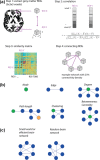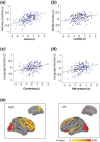A more randomly organized grey matter network is associated with deteriorating language and global cognition in individuals with subjective cognitive decline
- PMID: 29602212
- PMCID: PMC6055627
- DOI: 10.1002/hbm.24065
A more randomly organized grey matter network is associated with deteriorating language and global cognition in individuals with subjective cognitive decline
Abstract
Objectives: Grey matter network disruptions in Alzheimer's disease (AD) are associated with worse cognitive impairment cross-sectionally. Our aim was to investigate whether indications of a more random network organization are associated with longitudinal decline in specific cognitive functions in individuals with subjective cognitive decline (SCD).
Experimental design: We included 231 individuals with SCD who had annually repeated neuropsychological assessment (3 ± 1 years; n = 646 neuropsychological investigations) available from the Amsterdam Dementia Cohort (54% male, age: 63 ± 9, MMSE: 28 ± 2). Single-subject grey matter networks were extracted from baseline 3D-T1 MRI scans and we computed basic network (size, degree, connectivity density) and higher-order (path length, clustering, betweenness centrality, normalized path length [lambda] and normalized clustering [gamma]) parameters at whole brain and/or regional levels. We tested associations of network parameters with baseline and annual cognition (memory, attention, executive functioning, language composite scores, and global cognition [all domains with MMSE]) using linear mixed models, adjusted for age, sex, education, scanner and total gray matter volume.
Principal observations: Lower network size was associated with steeper decline in language (β ± SE = 0.12 ± 0.05, p < 0.05FDR). Higher-order network parameters showed no cross-sectional associations. Lower gamma and lambda values were associated with steeper decline in global cognition (gamma: β ± SE = 0.06 ± 0.02); lambda: β ± SE = 0.06 ± 0.02), language (gamma: β ± SE = 0.11 ± 0.04; lambda: β ± SE = 0.12 ± 0.05; all p < 0.05FDR). Lower path length values in precuneus and fronto-temporo-occipital cortices were associated with a steeper decline in global cognition.
Conclusions: A more randomly organized grey matter network was associated with a steeper decline of cognitive functioning, possibly indicating the start of cognitive impairment.
Keywords: Alzheimer's disease; MRI; cognition; connectivity; graph theory; grey matter network; longitudinal; mild cognitive impairment; subjective cognitive decline.
© 2018 The Authors Human Brain Mapping Published by Wiley Periodicals, Inc.
Figures


References
-
- Andrews, T. J. , Halpern, S. D. , & Purves, D. (1997). Correlated size variations in human visual cortex, lateral geniculate nucleus, and optic tract. Journal of Neuroscience, 17, 2859–2868. https://doi.org/Comparative Study Research Support, U.S. Gov't, P.H.S. - PMC - PubMed
-
- Benjamini, Y. , & Yekutieli, D. (2001). The control of the false discovery rate in multiple testing under dependency By Yoav Benjamini 1 and Daniel Yekutieli 2. Annals of Statistics, 29, 1165–1188. 10.1214/aos/1013699998 - DOI
Publication types
MeSH terms
LinkOut - more resources
Full Text Sources
Other Literature Sources

